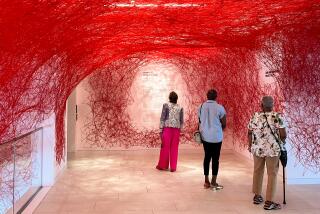Art as a barometer of climate change
- Share via
LONDON -- The vivid sunsets painted by J.M.W. Turner are revered for their use of color and light and for their influence on the Impressionists. But could they also help global-warming experts track climate change?
A group of scientists has studied the colors in more than 500 paintings of sunsets, including many of Turner’s 19th-century watercolors and oils, in hopes of gaining insights into the cooling effects caused by major volcanic eruptions.
By better understanding past changes in climate, they hope to improve computer models for future climate change.
Christos Zerefos, who led the research at the National Observatory in Athens, said he believed it was the first scientific study of art for clues to climate variations.
The scientists studied works painted around the times of major volcanic eruptions, such as the cataclysmic explosion of Mt. Krakatoa in 1883, to measure pollution.
“The initial idea arose from the fact that we saw an increased reddening of colors in sunsets which followed large volcanic eruptions, particularly Krakatoa,” Zerefos said.
By measuring the red and green in the paintings, the scientists aimed to calculate the amount of dust in the atmosphere. The greater the pollution, the redder the sunset, Zerefos said.
But Kevin Trenberth, who heads the Climate Analysis Research Center at the National Center for Atmospheric Research in Boulder, Colo., and who is not connected to the study, warned that artists and scientists do not necessarily see sunsets the same way.
“Painters are not scientists trying to do an accurate picture of nature,” he said. “They are artists trying to make something look good or dramatic.”
John Thorne, a professor of atmospheric meteorology at the University of Birmingham, who is not connected to the study, said that while there can be concern about painters taking artistic license, the study deals with that by using a cross section of artists.
The group examined 554 paintings from 181 artists and categorized 54 of them as “volcanic sunset paintings” because they were painted within three years of volcanic eruptions.
The volcanic group included paintings by 19 artists, including Turner, Claude Lorrain, John Singleton Copley, Caspar David Friedrich, Jules Breton, Edgar Degas, Alexander Cozens and Gustav Klimt.
The scientists measured the color ratio in all the paintings and found that those with the highest red to green ratio were in the volcanic group.
The study was published in the journal Atmospheric Chemistry and Physics.
More to Read
The biggest entertainment stories
Get our big stories about Hollywood, film, television, music, arts, culture and more right in your inbox as soon as they publish.
You may occasionally receive promotional content from the Los Angeles Times.










